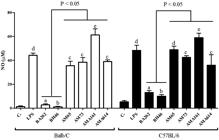Although Leishmania infantum is well-known as the aethiological agent of visceral leishmaniasis (VL), in some Central American countries it may cause atypical non-ulcerated cutaneous leishmaniasis (NUCL). However, the mechanisms favoring its establishment in the skin are still unknown. Lipophosphoglycan (LPG) is the major Leishmania multivirulence factor involved in parasite-host interaction. In the case of viscerotropic L. infantum, it causes an immunosuppression during the interaction with macrophages. Here, we investigated the biochemical and functional roles of LPGs from four dermotropic L. infantum strains from Honduras during in vitro interaction with murine macrophages. LPGs were extracted, purified and their repeat units analysed. They did not have side chains consisting of Gal(β1,4)Man(α1)-PO4 common to all LPGs. Peritoneal macrophages from BALB/c and C57BL/6 were exposed to LPG for nitric oxide (NO) and cytokine (TNF-α and, IL-6) production. LPGs from dermotropic strains from Honduras triggered higher NO and cytokine levels compared to those from viscerotropic strains. In conclusion, LPGs from dermotropic strains are devoid of side-chains and exhibit high pro-inflammatory activity.
Key words:
lipophosphoglycan; Leishmania infantum; innate immunity

 Thumbnail
Thumbnail
 Thumbnail
Thumbnail
 Thumbnail
Thumbnail


